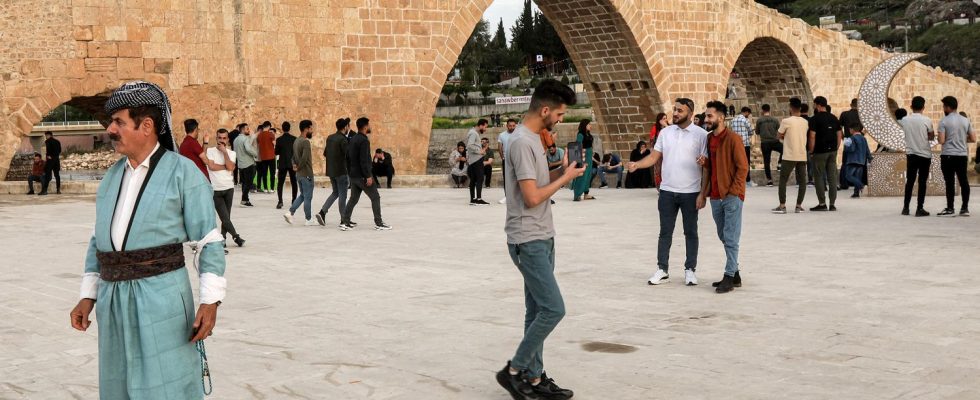Travel agencies offer to go to “red zones”, places considered at risk in Iraq, or to visit townships, poor neighborhoods in South Africa. Our correspondents explain to us what is at stake for these countries.

Published
Reading time: 6 min

While the World Tourism Fair takes place from Wednesday March 14 to Sunday March 17 at Porte de Versailles, in Paris, we are interested in a somewhat particular form of tourism, that which is increasingly present in dangerous or dangerous areas. disadvantaged. In Iraq, for example, travel agencies offer visits to “red zones”, places considered dangerous for tourists. While in South Africa, tour operators offer visits to townships, these areas, among the poorest, where black and mixed-race populations were forced to live under apartheid.
Iraq: 2.5 million tourists in less than a year
Some agencies have made it their specialty: organizing trips to countries like Ukraine, North Korea, Afghanistan and even Iraq. The Quai d’Orsay, like other European and American foreign ministries, classifies the entire Iraqi territory in the red zone for terrorist risks, kidnappings or linked to mines and explosives, among others. And yet, thousands of tourists go there every year.
In Iraq, this phenomenon of tourism in the “red zone” is not really new. For years, numerous groups on social networks have existed and exchanged advice for traveling independently across the country: visa procedures, where to enter, where to sleep, what sites to visit… The objective, as explained by a French academic returning from North Korea, and visited Baghdad a few months ago, is to discover the world off the beaten track. What particularly interested him was the multi-millennial Iraqi heritage that had survived the wars.
But the security question arises in these countries considered to be “red zones”. Haana Babashekh, project manager of a travel agency that has been organizing tours to Iraq for 30 years, explains that for their clients, precautions are taken depending on the evolving situation in the country. “For example, when it was not yet completely secure in Kirkuk and Mosul, we organized tours in Kurdistan and it was secure. And until it was completely safe for our guests, we were no longer offering tours to these locations. Who would have taken their clients to Mosul when Daesh was still there?” she says.
An economic issue for the country
The security situation has changed in Iraq since the end of the war against Daesh. Although it is still not recommended to travel to the country, the risks have decreased and tourism is returning. It is made easier by the possibility, since 2021, of obtaining a visa on arrival at the airport for many nationalities. Between the end of 2022 and mid-2023, 2.5 million tourists visited Iraq. Among them, more and more Europeans and Americans. “It’s quite safe and they are so interested in visiting Mosul. Even now we offer different types of tours, including visiting Yazidi camps, sitting with the families.”explains Haana Babashekh.
Iraq and Iraqi Kurdistan have been seeking to develop tourism, particularly over the past two years, by supporting the development of new infrastructure. The issue is economic, if the country remained stable, tourism could constitute a new financial windfall for Iraq which relies, for the moment, almost exclusively on its oil production.
South Africa: visiting townships encouraged by the government
Next to safaris and museums, in South Africa,Tour operators now offer visits to these areas where black and mixed-race populations were forced to live under apartheid, and which will still remain among the poorest in the country in 2024: the townships. The niche township tourism is even encouraged by the South African government, which seeks to diversify the offer for visitors. For those who organize them, these tours help open their eyes to the reality of the country. For example in the city of Cape Town, tourists could visit exclusively the city center and the vineyards, without ever knowing of the urban exclusion of the majority of the population. But there is always a risk of falling into a form of voyeurism and commercialization of poverty.
Everything depends, in fact, on the model chosen to think about these tours and visits. VSIn recent years, the emphasis has been placed more on the historical and cultural aspect, with a desire to change the outlook on the townships and highlight their dynamism and their creative side. But here too, the risk is to give a distorted image of places full of hope where people are happy with their conditions, as a study based on comments left on Tripadvisor recently demonstrated. And the organization of the tour must therefore be carefully well thought out. Finally, if the visits are organized with local communities, they represent financial benefits and sources of employment for areas often far from the economic centers of the country.
Tourism in schools in Zimbabwe
In the southern region, school tourism has also taken hold, particularly in Zimbabwe, and this is not without consequences there either. VSSome schools have developed different partnership models with tourist companies in order to obtain funding. In return, they undertake to open their doors so that international tourists can visit them and interact with the students. The little research that has been done on this type of tourism has shown that these visits disrupt the rhythms of teachers and schoolchildren, not to mention that they can reinforce stereotypes about Africa, although they contribute to the economic functioning of such schools.
